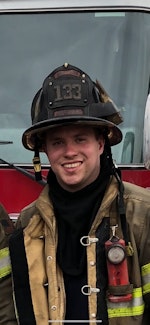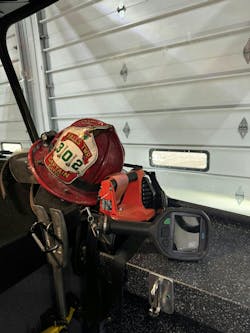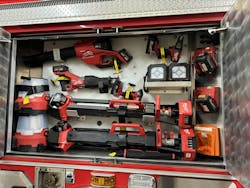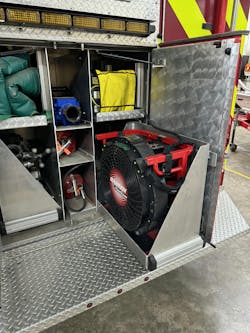When we think about truck company operations and the fire department, what often comes to mind is the quintessential hook and ladder. However, numerous things that truck work involves don’t involve having a rig that has an aerial device on it. Quite honestly, most of the time, these functions are performed on the fireground without a single “truck company” even there.
Truck work is a mindset, and it’s a mindset that requires preparation mentally and physically. One of my most important mentors is Capt. Greg Lash, who retired from the Columbus Division of Fire and served on Ladder 1. Lash always says that truck company firefighters are successful because of experience and training (as well as common sense). We all know that experience is something that we get right after we need it, so it’s difficult to plan for that, but we can prepare with training. Training for an engine or other company that might function as a truck company must include, of course, truck company functions but also efforts to gain understanding of who is responsible for what, who assumes what roles on the fireground and how all of this is clearly communicated. Training together is important, so when it’s game time, it’s a seamless transition.
Well-defined standard operating procedures that provide for a well-understood system provides the most clarity for members.
Members also must train on communicating both on the radio and face to face. If members don’t practice how and what to say before they get to the fire scene, what they say might not deliver the message that they intended.
The other part of preparation for successful truck company operations is having the right equipment and knowing how and when to use it.
Property protection
Often, simple things can have the most effect at some fires. For example, I have heard and read many times that salvage is a lost art within the fire service. A simple and easy task can buy us a lot of equity from those who we serve.
You don’t have to carry canvas salvage tarps on every engine, but a roll of plastic sheeting can make all of the difference in preventing further damage. This is the part where planning and training come in.
Recently, my department responded to a small attic fire that originated from a light fixture. The second engine arrived, and as the crew prepared to begin overhaul, the chauffeur brought two tarps to the door. Fireground commanders who have a heads-up chauffeur can have one thing taken off of their check list.
Companies that operate inside can begin to move things to the middle of the room to be covered and can take the extra time to remove pictures from walls and make sure that important items are re-covered or protected. These members must think ahead in regard to where water and debris will go once they come off of the cover. Pushing water onto something else just creates another problem.
Forcible entry & search
Setting up your rig for success also contributes to engine crews being successful at truck work. If the tools that you need are buried in the back of the rig under a pile of other equipment—or, worse yet, not even on the apparatus—what can be accomplished on the fireground will be limited.
Forcible entry tools and hooks are the hallmark of basic truck company functions. Getting members and a hoseline to where they need to be to extinguish the fire is vital. We must be in the building searching for occupants and searching for fire and then opening up for hidden fire in ceilings, knee walls and void spaces. One drill that I highly recommend for any engine company that might find itself functioning in the role of a truck company is practicing one-person forcible entry. Being proficient at this prepares an individual to function alone while crewmates focus on making their stretch.
A Halligan, a box light, a thermal imaging camera (TIC), a set of irons, a 2½-gallon
water can and hooks must be accessed easily for deployment on every fire run, from automatic alarms, to odors of smoke, to working fires. The pressurized water extinguisher, or “can,” is just as important a tool as the hose is on the engine.
By having the mindset of preparation, a firefighter can stop a can fire from becoming a multiple-alarm fire. On scene of a working fire, functioning in the truck company role, a heads-up inside team that’s equipped with a water can and its hand tools can make the difference between life and death for the civilians who we swore to protect.
We might respond to nine fires in a row and search. We might arrive to an “all clear per the occupant.” Either situation might lead us to just go through the motions. This isn’t acceptable. Our mindset must be to expect victims and conduct thorough and proper searches every time that we have conditions on the fireground that allow it. The tenth fire might be the one where someone is trapped, someone went back in or an occupant didn’t account for someone.
If a member is searching off of the hand-line, that person must train on that tactic to implement it most effectively. My department’s firefighters treat searching off of the handline like an “oriented search.” The hoseline becomes the wall and is used as a navigational beacon to move through the building.
I have heard many different methods for extending off of the hoseline, including tools or webbing, but I believe that with sound communication skills and knowledge of building construction, firefighters can effectively and safely search a room in a residential building without holding onto a rope or another firefighter’s foot.
TICs
The thermal imaging camera (TIC) is a piece of mission-critical equipment for any type of fireground operations, but when engine crewmembers function as a truck company, it’s paramount to their success for multiple aspects of the operation, particularly search and rescue.
When my first volunteer fire department bought its first thermal imager, it was the size of a boat anchor. The technology that we have available to us in 2024 is vastly different than predecessor versions, and if you ever have the chance to attend training that’s offered by my good friend, Andy Starnes, and his group at Insight Training, your eyes will be opened to how effective you can be conducting search and rescue with the TIC.
This doesn’t mean that it’s OK to forget the basics. The TIC is a tool that enhances our effectiveness, with a byproduct of efficiency and safety. That’s one reason why we take that box light, too, because when the camera doesn’t work, all of us must remember the basics.
Saws, fans & lights
Truck companies play a large support role on the fireground, and crews from other companies that serve in that role must make sure that all of the ancillary equipment that’s needed makes it to the fire scene and off of the rig.
Battery-powered technology made tremendous progress over the past three years. Because of this, so has the equipment (e.g., battery-powered saws, fans and lighting) that firefighters use.
Battery-powered saws most certainly can provide the capability for one firefighter to soften a building or remove a fence. Some might not believe that current battery-powered saw technology is in the right place to be adequate for roof ventilation; however, the tools certainly offer so much to the fireground, including cutting locks and fences for forcible entry and having as a part of a RIC complement, because they operate in an oxygen-deficient environment.
Battery-powered fans that move more CFMs than corded fans, don’t produce carbon monoxide, and are light and maneuverable are emerging and are competing with some gasoline-powered models. At the scene of a fire, I am not concerned with a gasoline-powered fan producing a small amount of carbon monoxide when it’s positioned at the front door, but what about when I’m in an apartment building or a large residence and the fan must be positioned elsewhere? Battery-powered fans give me that capability.
The least glamorous and probably most overlooked item that’s noted above is lighting. I am not ashamed to admit that I am a sucker for an LED quartz light that has a plug on the end of a junction box reel that I can toss in a window. We often forget that we must see both inside and out at the fire scene.
A chauffeur or even backstep firefighter who’s trained to take a ladder to the rear also should be trained to take a light, particularly at night. A light that’s positioned in an above-ground window, a basement window or a door could be all that firefighters or civilians need to orient their way through the smoke to safely make their exit. As well, a well-lit exterior could illuminate a hazard (for example, a downed power line) or be the means to prevent a sprained ankle.
Something inexpensive that can be done with battery-powered lights is to attach a carabiner to the light, so the light can be attached quickly to the top rung of a ladder or clipped on a webbing strap and set inside of a window.
What matters is finding what works for you and making sure it gets used. None of this equipment does anyone any good sitting in the compartment on the rig.
Fundamentals
Nothing that’s noted above is earth-shattering, but what can be said again and again is the difference that can be made with training and preparation. A tailboard discussion on the apparatus floor and a 15-minute drill can set a company apart. Attention to detail and knowing one’s equipment take members to the next level.
Someone said to me once, don’t be in such a hurry to complete your apparatus check. Pick a tool each day and take the time to learn and understand it better.
Success comes from a system of fine-tuned and well-executed basics.

Jacob Gates
Jacob Gates is a firefighter for the Mifflin Township Division of Fire in Gahanna, OH, serving in both engine and truck companies. He also is a captain for the Falls Township Fire Department in southeastern Ohio and a lead instructor for the Ohio Fire Academy.








